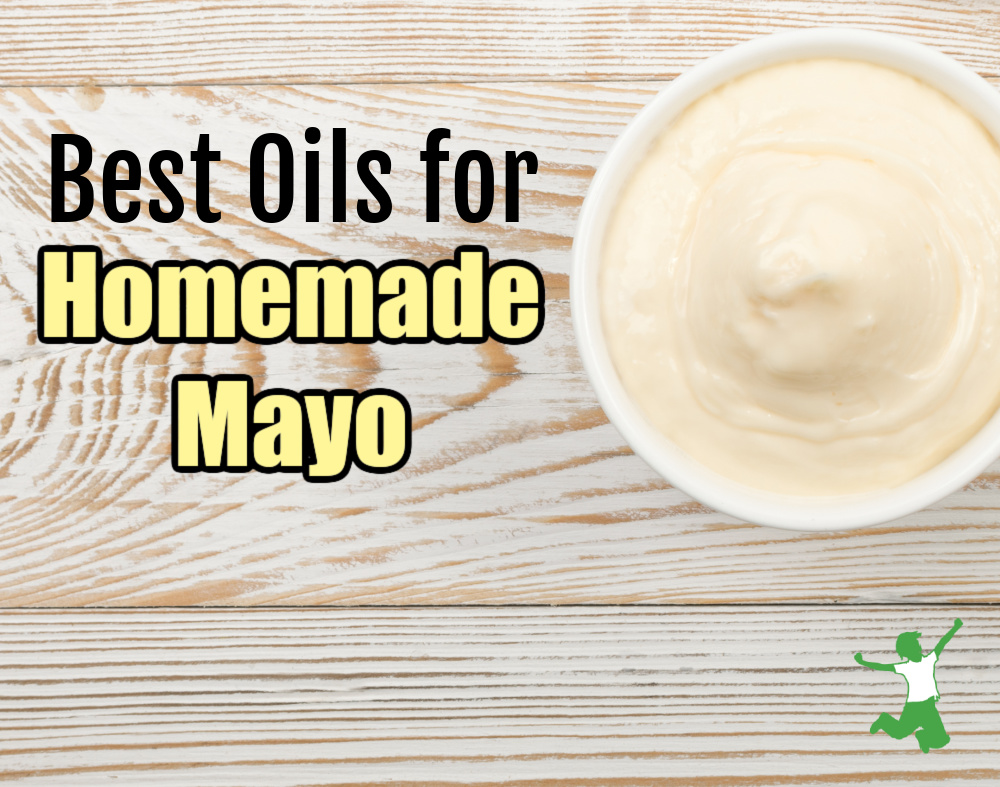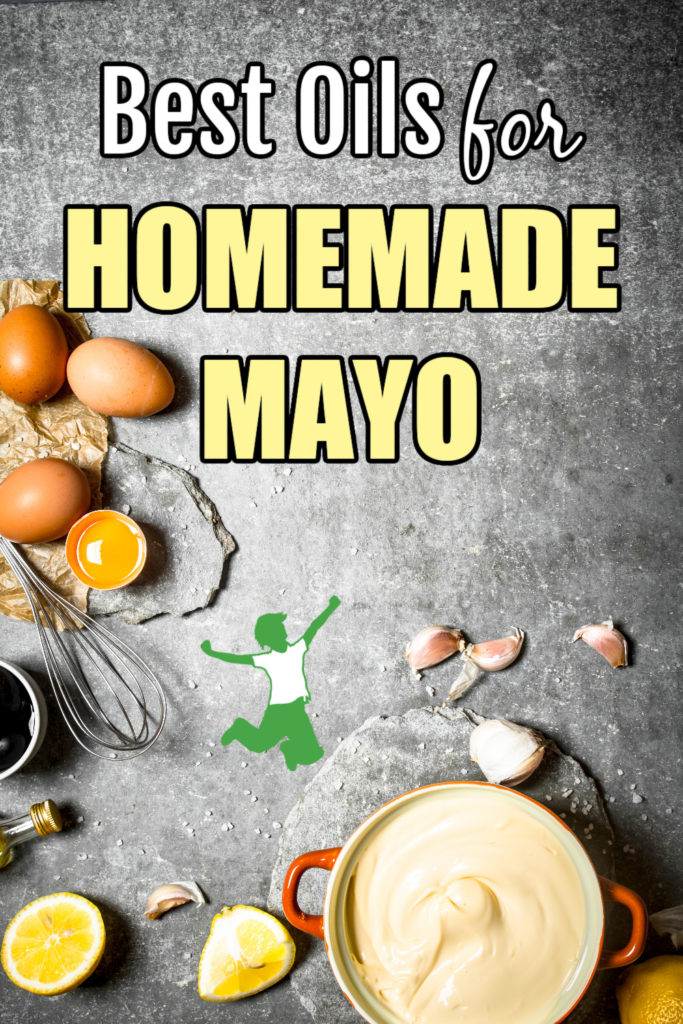Table of Contents[Hide][Show]
Which oils to consider for making nourishing homemade mayonnaise and which is best based on taste, consistency and healthy fat content.

Life without mayonnaise? Perish the thought! It is an essential condiment in the kitchen and learning how to make healthy mayo yourself is so simple and easy that once you give it a go, you won’t be settling for anything from the store – including the healthfood store – ever again!
Even homemade eggless mayo is super simple to whip up yourself. Psst. Don’t use aquafaba though!
The smooth, creamy texture and sheer elegance that quality mayo imparts to sandwiches, salads, and sauces are certainly unrivaled at least in American cuisine.
Never does the thought cross my mind to “go light on the mayo”. If I am feeling like a huge dollop or two, I feel free to indulge myself given that the mayo I insist on using is of superior freshness and quality and made with health-boosting oils and liquid whey for additional digestive enzymes and even probiotics.
Given that the fats used in the mayo are the most critical ingredient, which oils are the best ones to select?
Sunflower or Sesame?
I tell folks that when making mayo for the first time, use sunflower seed oil as this will give the closest consistency and taste to store mayo.
However, sunflower oil is a high omega-6 oil. This is fine if one follows whole food, traditionally based diet where the omega 3 to omega 6 fatty acid ratio is roughly between 1:1 and 1:4.
If one is still in the process of transitioning off processed foods, however, a lower omega-6 oil is probably a better choice. This is because processed foods are loaded with rancid omega-6 oils. Too much in your diet encourages inflammation.
Note that including even a few processed foods in the diet can skew that omega-3 to omega-6 balance in a hurry!
If you are concerned about your omega-6 intake, unrefined sesame oil is a good choice for mayo as it is higher in oleic acid (monounsaturated, omega 9 fat) and lower in omega-6 fats (polyunsaturated) than sunflower oil. Oleic acid is the healthy fat found in great quantity in avocados and olive oil.
Olive Oil
If oleic acid is so fantastic, then why not just use extra virgin olive oil for mayo?
While this can be a good choice for some, many folks find the flavor of olive oil mayonnaise too strong.
Using half olive oil and half sesame oil is an option for a milder taste which is still high in oleic acid.
In addition, some folks find that olive oil really packs the weight.
Oleic acid is a long-chain fatty acid and is more likely to contribute to the buildup of body fat than shorter chain fatty acids found in coconut oil or ghee. Let’s talk about both of those next.
Coconut Oil or Ghee
What about ghee or coconut oil for mayonnaise?
I’ve made mayo with ghee before and it turns out absolutely fabulous. The one drawback is that the mayo turns out too rich in my opinion. It also hardens in the refrigerator and loses consistency when brought to room temperature.
Since I like to use a lot of mayo, using all ghee doesn’t really work for me in most situations. However, half ghee and half sesame oil can work to lighten up the richness factor a bit.
A similar problem happens with coconut oil mayo. It hardens in the fridge and can’t be used quickly for chicken salad and other dishes.
If you choose to make coconut oil mayonnaise, be sure to use expeller-pressed, which is flavorless. Virgin coconut oil results in a coconut flavored mayo, which some people do not enjoy.
Blended Oils
Another option for homemade mayo is to blend fats together to achieve a good taste and consistency.
One I’ve used in the past is 1/2 sunflower or sesame oil and 1/2 expeller pressed coconut oil.
Since coconut oil goes very firm below 76 F/24 C, using half expeller-pressed coconut oil produces a mayo that is very thick and scoopable even after refrigeration.
Another option suggested by the Weston Price Foundation is what’s known as “Mary’s Blend” after the late Dr. Mary Enig, a PhD in lipids. She suggested a blend of 1/3 olive oil, 1/3 sesame oil, and 1/3 coconut oil.
Avocado Oil. My Favorite Fat for Mayo
As you can see, there are numerous options for healthy fats for making mayo.
Judging based on taste, nourishing lipid content, and consistency (both at room temperature and refrigerated), my favorite is avocado oil.
It is mild tasting, has a fatty acid profile similar to olive oil, and the mayo stays creamy in the fridge.
If you must buy, there are a couple of brands now available that are acceptable. This is the brand I use in a pinch. The only downside is that it does not use raw egg yolks, and it is a bit pricey.
Be sure to check my Resources page for a list of brands I trust that supply quality oils for all your mayo-making endeavors!
Here’s a short video of what avocado oil mayo looks like after I made a batch.









There’s a link in the third sentence that links to a video on how to make the mayo.
What IS the best recipe then??I do not see it posted -any links ?
concerning expeller pressed coconut-is it not as healthy as virgin? is that why you suggest it for something like mayo but not in general?
more processed = less good stuff, but also less flavour. For fried eggs or mayo, less is more!
If you use a Greek or Mediterranean olive oil your mayo will taste much more neutral. Italian olive oil is a little peppery and strong for use in mayo.
Would organic grapeseed oil be a good choice?
Grapeseed is high in omega 6 fats like sunflower so not an ideal choice. It is also sometimes industrially processed using solvents like hexane and traces would be left in the oil.
This is really funny because I just made this recipe last weekend for a potluck (which was a massive hit), and made my first batch of mayo for it: I made it with coconut oil and because the consistency wasn’t coming together, splashed in some sunflower oil I happened to have and it was perfect! What I would really love to try is the suggestion a commenter made on the mayo recipe on The Nourishing Cook for using bacon drippings as the oil. I imagine it would be like the ghee and very rich, but bacon mayo sounds heavenly.
I’m definitely going to try bacon mayo soon!
I think I’m going to try that too! I save my bacon grease and cook with it sometimes (guilty secret!)
What great info! …My family found the EVOO alone to be too strong, and I BLESS you for telling the news about its association w/weight-gain. I haven’t tried our coconut oil because of the coconut taste-never considered using non-virgin, so maybe we’ll give that a try. We have been making it w/a mix of EVOO and Organic Peanut Oil with good, thick results, but again, I was unaware of the weight-gain possibilities from peanut oil…another good reason to give the non-virgin coconut oil a shot. Thanks!
How about macadamia nut oil, I just bought some.
I have used macadamia nut oil, which is the lowest in PUFAs except for coconut oil, in combination with EVOO. I’ve also used sesame, coconut oil and EVOO. Last time I made way too much, we didn’t use it and it started to taste off so we fed it to the dogs! I always go the lacto-fermented route, too, but I think I didn’t let it culture enough last time. This morning I used mostly avocado oil, with some EVOO and a tiny bit of macadamia nut oil. The directions for mayo in Sally Fallon’s “Eat Fat, Lose Fat” say to let it culture on the counter for 7 hours for refrigerating (this is if you’ve included some whey). It turned out great!
I have tried hemp oil, olive oil, and macadamia nut oil and the macadamia was by far my fav! Hemp was good but it sounds like hemp is not that great for you? The only down side to the macadamia nut is that anything I make it with I can’t give leftovers to the dogs, macadamia nuts are toxic to dogs.
And, regarding the grapeseed oil…Wow! I didn’t know that. Is that true of all grapeseed oils? Is there such a thing as an organic grapeseed oil? Or, do they pull the same stunt there as is done in baby formula: using hexane or benzene to extract their omega oils to create toxic lipids that arethen put in every baby formula on the market–and still get away with calling it organic (!!!)?
Deb- that is what I used was the” palm oil” shortening from Tropical traditions
That is a good idea!